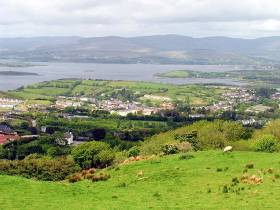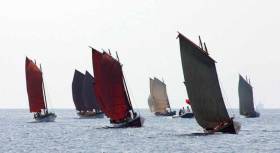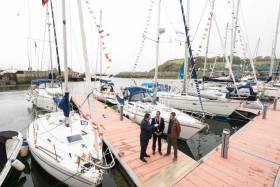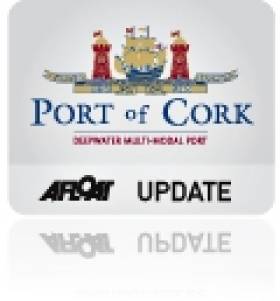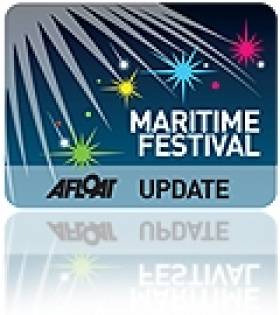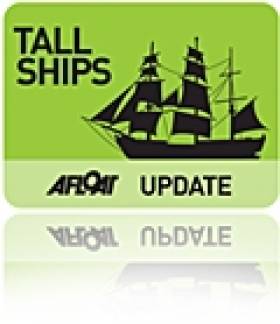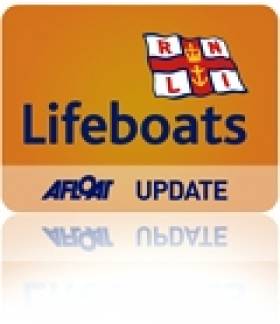Displaying items by tag: Bantry
Bantry Bay Port Is Not Included in Port of Cork's ‘Masterplan’
The south-west port of Bantry Bay has not been included in the Port of Cork's major new masterplan, the company confirmed last week.
According to the Southern Star, the Port of Cork Company (PoCC) is planning to share the emerging concepts of the ‘Port Masterplan 2050’ in a series of consultation meetings.
Afloat adds these meetings have taken place in Ringaskiddy, Cork and most recently in Cobh (see related story: By 2030 Port of Cork to vacate city centre).
The port area of Bantry Bay Port Company, which comes under the auspices of PoCC, is however not included in the 'Port Masterplan 2050'
The Masterplan will allow the company to adapt to a shifting landscape in port operations and plan its development as a key global port of the future.
For more on this the newspaper reports.
In addition to a story on a joint venture project (announced in 2021) to build on Whiddy Island a green energy plant.
Resolving Bantry's Flooding Problems
The Bantry inner harbour development scheme has re-generated interest in the West Cork town as a marine leisure and sailing centre. Bantry Bay Port Company, operated by Cork Port, has a sheltered marina with 40 berths there.
But the town centre itself, on the edge of the bay, has suffered a lot from flooding during the past few years.
“It has been severely and repeatedly impacted,” according to Cork County Council which has announced a ‘Public Participation Day’ next week to discuss the flood relief scheme it is planning for the town.
Several factors have caused the problems, including tidal issues, according to Cork County Council CEO, Tim Lucey. “The Bantry Flood Relief Scheme involves the analysis of several very complex factors, including tidal, fluvial and pluvial flood mechanisms. Constraints include environmental factors, cultural and heritage elements, and impacts on existing infrastructure.”
The ‘Public Participation Day’ will be held in the Council offices in the town centre - Áras Beanntraí - at Wolfe Tone Square next Wednesday, May 18, between 4 and 8 p.m.
This is to assess public opinion about the scheme, the first stage of which involves a detailed study of flooding mechanisms in Bantry and its environs, involving data collection, site investigation, hydraulic and hydrological assessment, and public consultation. Presentations will be given by the project team to identify a preferred option.
“It is an opportunity for the public and business people to share their experience of flooding in Bantry, submit comments and make their views known,” said County Cork Mayor Gillian Coughlan. “The scheme will provide critical infrastructure to protect Bantry against significant flood events in the future. Different options will be assessed and the most appropriate solutions brought to planning stage.”
Local Fisheries Groups Across Europe To Discuss ‘Smart’ Solutions To Coastal Challenges In Bantry Next Month
Fisheries Local Action Groups (FLAGs) from across Europe will be meeting in Bantry next month to discuss “smart” ways to tackle coastal challenges.
The Smart Coastal Areas seminar, hosted by FLAG South and Bord Iascaigh Mhara at the Westlodge Hotel from Tuesday 2 to Thursday 4 April, aims to provide ideas and guidance on ‘smart’ development — including activities, development models and ways of working to boost the fisheries industry and coastal regions in an innovative way.
In 2017, the GDP of the Irish seafood sector was estimated at €1.15 billion. More than 14,000 people are employed in Ireland’s seafood sector, many of whom work and live in rural coastal communities.
Fisheries and coastal areas are impacted by factors such as depopulation, ageing population, climate change and economic decline.
The EU’s European Maritime and Fisheries Fund (EMFF) was set up to support initiatives by local fisheries communities through Community-Led Local Development (CLLD). FLAGs can use this money to implement projects that support sustainable small-scale fisheries and aquaculture production, and coastal communities.
However, funding is not the only answer, as creativity and strategic action is also needed.
The Smart Coastal Areas seminar will highlight:
- Smart partnerships (creating win-win situations between different interest groups)
- Smart resource use (optimising local resources and production systems)
- Smart financing (reaching small-scale beneficiaries: micro-credit, etc)
- Smart services (adapting services to ensure their viability: smart harbours, connecting remote areas, etc)
The seminar will include presentations on FLAG projects in EU countries that demonstrate smart approaches to rural sustainability and development. Local examples from the Cork coast are Courtmacsherry Community Shop and Schull Bait Bins, both supported by Ireland’s FLAG South.
Also included with the seminar will be a field visit to local fisheries-related businesses as well as Whiddy Island to view the progress of a tourism-related project.
11 International teams will make Antrim their home for the International Contest of Seamanship tomorrow.
As Afloat.ie reported previously in March, 200 young people from USA, Russia, St Petersburg, Belgium, Ghent, GB, Ireland, Quebec, France, Denmark, Canada and Northern Ireland will compete, live and learn together.
During the week long contest the 38ft wooden gigs will be sailed and rowed. Teams will undertake various skill tests, including navigation, rope work, Jack Stay Transfer, Captain’s Gig, Slalom and Man overboard rescue.
Spectators will have a great view from the Lough Shore of the 11 picturesque gigs as they race on Lough Neagh.
The contest takes place every two years and Northern Ireland has competed in Canada, Finland, Ireland, Italy, France and Denmark in 2016.
"The Challenge for the crew is to learn to sail and row a 38ft Captain’s gig and use it in friendly contests"
The Challenge for the crew is to learn to sail and row a 38ft Captain’s gig and use it in friendly contests, including the biennial contest of seamanship with young people of other nations. To build a team that makes new friendships, new understanding and builds trust that spans frontiers. Also to be ambassadors among people of other nations, competing overseas in one of the member nations.
The gigs are replicas if 18th-century admiral’s barges, used by fleets in harbour for transport between ships and shore. The design was drawn from a French naval model, but such boats were common two centuries ago to the navies of Britain, France, Russia Spain and Sweden. Technically they are long boats but common usage and history have led Atlantic Challenge to use the term “gigs” or “Bantries. The model from which they are built dates from the French invasion of Ireland at Bantry in 1796.
Northern Ireland has had 2 gigs Harmonie was launched in 2003 by Dame Mary Peters and the crew are now sailing Cwch John Kerr, named after the boat builder credited with bringing the organisation to the UK.
We are a cross community, cross gender organisation, giving equal prominence to all individuals in our team. We welcome applicants from all corners of Northern Ireland. Our gig Cwch John Kerr is based at Antrim Boat Club on Lough Neagh.
Northern Ireland became World Champions in 2012.
Dame Mary Peters is our Patron and will open the International contest in Clotsworthy Gardens.
The contest will start in earnest this Saturday morning, with at least two races or tasks every day for the week. This is a strong test of the crew’s physical strength and endurance as well as requiring teamwork, quick thinking and ingenuity. All teams striving to be World Champions.
The experience of mastering the gigs, living with people from other cultures and learning new skills is life-changing for the young people. They grow in confidence, life experience and make new friends. The experience of the contests is something the crews will never forget.
It is an honour for Antrim Boat Club to be chosen to host this Contest. The visitors are all looking forward to enjoying the welcome, sights and traditions of Northern Ireland.
The Northern Ireland crew is made up of approx. 20 young people from the local area, Antrim, Randalstown, Doagh and Templepatrick with previous crew returning from Glasgow, New Zealand and Guernsey for this important contest. Under the expert supervision of Michael Patton the cox, the crew have been training every Sunday at Antrim Boat Club to prepare for the contest.
The opening ceremony will take place in Clotsworthy Gardens at 4:00 on Friday 20th July 2018. Everyone is welcome to view the teams and contest.
Royal Cork Joins Port Companies To Promote Cork Marine Leisure At Southampton Boat Show
#Tourism - The Port of Cork, Bantry Bay Port Company and the Royal Cork Yacht Club are joining forces to promote marine leisure in Cork at the Southampton Boat Show.
The three organisations are in attendance at Stand J047 from today Friday 15 to Sunday 24 September tasked with promoting their marina facilities to potential visitors.
They will also be targeting the luxury cruisers and motor yacht market to entice further calls to Cork, Crosshaven and Bantry.
In 2009 the Port of Cork implemented the Leisure and Recreation Strategy for Cork Harbour, with the primary focus of the strategy on water-based leisure and recreational activities in and around the harbour.
Speaking about attending the boat show, Sara Mackeown, commercial marketing executive for the Port of Cork, said: “This is great opportunity to showcase Cork as an ideal destination for marine leisure users.
“Our marina facility in the heart of Cork City is unique and having just completed the new Bantry Harbour Marina there is a great connection now between Cork and West Cork. We are delighted to work closely with the Royal Cork Yacht Club, who have huge experience in the field.”
Cork Harbour offers significant potential for further development of the marine recreation sector as an important source of enjoyment and economic gain for the local residents and visitors, and it is anticipated that attending the Southampton Boat Show will help to promote the marine facilities directly to the desired market.
Gavin Deane, general manager of the Royal Cork Yacht Club said: “The Royal Cork Yacht Club are delighted to be collaborating with both the Port of Cork and Bantry Bay Port Company in promoting the region.
“This year we have seen a significant increase in the number of visiting boats to our marina, the majority of whom have travelled from the south coast of the UK.
“We feel that with this growth in visitors, now is the ideal time to showcase everything that Cork has to offer and Southampton Boat Show 2017 is the place to do it.”
#portofcork – The Port of Cork today outlined plans for Phase 1 of the Bantry Inner Harbour Development which the Port of Cork will undertake on behalf of its subsidiary company, Bantry Bay Port Company.
The scheme marks the start of the regenerating of the inner harbour and is in keeping with the total Inner Harbour Development scheme which was developed by the Bantry Bay Harbour Commissioners in 2012 and planning permission was granted in 2013.
Now being advanced by the Bantry Bay Port Company, the scheme will provide a more sheltered harbour environment and marina with increased water depth and improved pier facilities which will promote fishing and tourism activities in the Bantry area.
Phase 1, which is likely to cost €8.5m, will consist of the following principal elements:
· 20 berth Marina (quayside pontoons)
· Dredging to a depth of 4 metres to allow vessels access to the inner harbour
· Remedial works to Town Pier (widening and extending)
· 4,000m2 of reclaimed landscaped amenity area
· Construction of 60m long floating breakwater pontoon
· Beach nourishment at Cove site
Commenting on the development, Brendan Keating, Chief Executive of the Port of Cork said that there are many benefits for Bantry and the wider Harbour area in undertaking such a project. "Works to the Town Pier will ensure improved longevity of the existing pier structure and improved access and facilities on the pier will facilitate existing activities and hopefully generate more commercial activity for Bantry Harbour. There will be improved berthage available for larger marine vessels and the Company would hope that this will lead to an upturn in marine leisure in and around Bantry Harbour" he said.
It is expected that construction will commence on the project in Q4 2015 and will be complete in Q1 2017. The work will be phased in order to minimise impacts to pier operations and to minimise traffic and amenity impacts for the town.
Bantry Bay is the largest of the long marine inlets in south-west Ireland. It is approximately 35 km long, running in a south-west to north-easterly direction. The entrance to the bay is approximately 10 km wide, steadily narrowing to 3-4 km at its head. Bere Island, situated on the north shore adjacent to CastletownBere, and Whiddy Island lying near the head of the bay on the southern shore are the two largest islands in the bay.
#maritimefestival – There will be a number of maritime themed events at the 2014 West Cork Literary Festival in Bantry, Co. Cork which runs from Monday, July 7th to Friday, July 11th with many free events.
On Friday July 11th in Bantry Library Rose George, the winner of the 2013 Mountbatten Maritime Award for Best Literary Contribution, will give a free talk about her fascinating journey into the hidden world of shipping. Her pursuit of the shadowy truths behind the industry that brings us almost everything we eat, wear, and work with, took her across the globe. "Deep Sea and Foreign Going: Inside Shipping, the Invisible Industry that Brings You 90% of Everything" is essential reading for anyone curious about the complex systems behind our convenient modern world. She follows the routes travelled by mercantile and naval fleets, pirate gangs, and illegal floating factories.
Philip Hoare will read from his yearlong adventure through the world's oceans. "The Sea Inside" on Thursday, July 10th. In colourful prose and lively line drawings, he sets out to rediscover the sea and its islands, birds, and beasts. Starting at his home on the shores of Britain's Southampton Water and moving in ever widening circles—like the migration patterns of whales—Hoare explores London, the Isle of Wight, the Azores, Sri Lanka, Tasmania, and New Zealand. Philip, winner of the 2009 Samuel Johnson Prize for non-fiction, is a broadcaster and author, he wrote and presented the BBC Arena film, "The Hunt for Moby-Dick", and directed three films for BBC's Whale Night.
On Saturday, July 12th there will be a special event on Whiddy Island, starting with the ferry across we celebrate Bantry Bay, the sea beyond and the lore and poetry of West Cork. John Mack, author of "The Sea: A Cultural History" draws on histories, maritime archaeology, art history and great literature to provide an innovative account of the great blue yonder and his own love for Whiddy. Philip Hoare will read from "Leviathan or, The Whale" his award winning book and film, which is also the story of our own obsessions. Leanne O'Sullivan from the Beara Peninsula will read from her poetry collections "Cailleach, The Hag of Beara" and "The Mining Road". She is the recipient of The Rooney Ireland Chair of Poetry Bursary and Lawrence O'Shaughnessy Awards.
Of course, younger readers are looked after too with the interactive Monster Sea Doodle! Travel 50 leagues under the sea with Captain Olivia Golden, illustrator extraordinaire, and learn how to draw some of the creatures that tickle, wriggle and swim in the salt water off the Bantry coast. Monster Sea Doodle! Takes place on Tuesday, July 8th, in St Brendan's School Hall
Ben Okri, Jonathan Miller, Blake Morrison, Karen Joy Fowler and Jennifer Johnston are just some of the guests announced for the renowned West Cork Literary Festival this July. The West Cork Literary Festival runs from July 6th to 12th and is generously supported by The Arts Council, Cork County Library and Arts Service and Fáilte Ireland. Booking on www.westcorkliteraryfestival.ie, Telephone: 027 52788/9
Sail Training Schooner Locked Up Since 2007
#TALL SHIPS - The flagship vessel for an Asgard-type sail training programme in Cork has been locked up in a boatyard since 2007, the Irish Examiner reports.
The Omar B was supposed to be the focus of a Youthreach project based in Bantry for early school leavers. But the schooner has spent the last four-plus years in storage in Baltimore, and has been deteriorating due to lack of maintenance - despite the scheme still notionally running, the newspaper report says.
Five two-man dinghies purchased with grant money have also reportedly spent most of 2011 in storage.
Co Cork's VEC has now put the €150,000 sailing programme under review following concerns over storage costs and lack of direction for the project.
The 75ft Omar B was donated to the CCVEC by owner and builder Don Attig in 2003 and refitted for use by students thanks to generous voluntary funding. Attig said the boat was of immense benefit to students who would not otherwise be in education.
The Irish Examiner has much more on the story HERE.
Castletownbere Lifeboat Transfers Injured Man from Bere Island to Bantry in Blizzard
Lifeboat crew with Castletownbere RNLI launched this afternoon (Tuesday 21 December 2010) at 3.30pm to transfer a man from Bere Island to Bantry in West Cork after he was injured in a fall. The lifeboat crew had to step in after heavy snows made the roads in Bantry impassable and stopped the ferry running.
The man in his thirties was transferred onto the lifeboat at Bere Island and brought to Bantry to be met by a waiting fire brigade. The casualty was then brought to hospital for treatment. Conditions at sea were fair but with a very heavy snow falling.
Commenting on the callout Deputy Second Coxswain Paul Stevens said, "This was a callout in very challenging conditions. Due to the heavy snowfall in West Cork the roads in some places are impassable and travel is very difficult. We were delighted to be able to help out and ensure that the man was transferred quickly to receive emergency treatment. Our lifeboats are there to save lives wherever we can."
Related Safety posts
RNLI Lifeboats in Ireland
Safety News
Rescue News from RNLI Lifeboats in Ireland
Coast Guard News from Ireland
Water Safety News from Ireland
Marine Casualty Investigation Board News
Marine Warnings


























